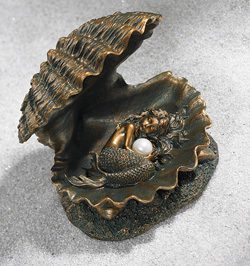The Summer Solstice, or Midsummer, is celebrated by many cultures throughout the world. Although it is the longest day of the year, within the great circle of the seasons Midsummer also marks the time when days become shorter, leading us out of summer and into fall. To mark this event, early cultures would light fires on Midsummer eve to speak to the sun, convincing it to reach its zenith and continue on its yearly journey. As John Matthews reminds us in his book The Summer Solstice, the light of the fires were thought to call the sun back to earth, to warm it and to bring the promise of life renewal to the lands. It was a purification of the land and its people, and a cleansing of negative forces in general.
St. John the Baptist
| Inlaid Shell Celtic Cross, $59 |
Biblical reckoning places the birth of John the Baptist six months before the birth of Jesus. Therefore, the early Church, in the way it had incorporated Winter Solstice celebration into Christmas, adapted Summer Solstice celebrations to the festival of Johnsmas, or the birthday of John the Baptist. This holiday also came to be known as Summer Christmas.
The ancient act of lighting cleansing fires on Midsummer’s Eve easily translated to celebrating St. John the Baptist, who was said to have brought Jesus out of the world of darkness with his baptism, purifying his soul and mission. So it is for Christians that St. John’s Eve is a night of purification and the fires an act or beacon of light.
Customs Associated with St. John’s Eve
| Embroidered Wildflowers Top, $56 |
Flowers and greenery also figure in the festivities. Houses and revelers alike would be decked in fresh blossoms and greenery. While many plants were simply for decoration, some such as St. John's Wort, were also thought to bring protection and were left in place. Bouquets of significant herbs and flowers would be tossed into the bonfire.
Plants and light combine to a natural celebration of the pinnacle of the sun's journey. John Stow, in his 1603 Survey of London noted on Johnsmas eve "Every man's door being shadowed with green Birch, long Fennel, St John's wort, Orpine, white lilies and such like…some hung out branches of iron …containing hundreds of lamps lit at once."
Celebration Suggestions
| Stone Candleholders, $20 - $62 |
In celebration of St. John the Baptist’s Eve, consider personal devotions and contemplations, as well as customs that promote personal renewal and growth. There are many symbolic ways to celebrate, including:
o Burn a bonfire in honor of St. John and throw onto the fire a traditional mix of midsummer flowers and herbs, including: Lilies, Birch, Fern, Yarrow, Verain, and St. John’s Wort.
o Write down any transgressions of the past year on a piece of paper and burn it in the fire of St. John, symbolizing your commitment to start anew for the coming year.
o Spend a quiet evening in your garden, lighting (protected) candles at sundown, and contemplate the gifts of light and of dark.
o Decorate your home with summer flowers and blossoms.


